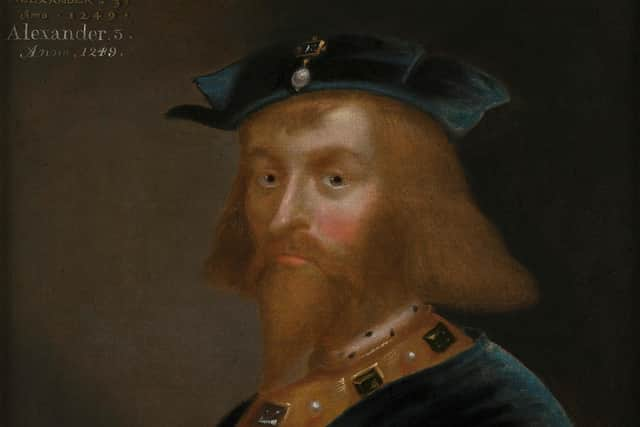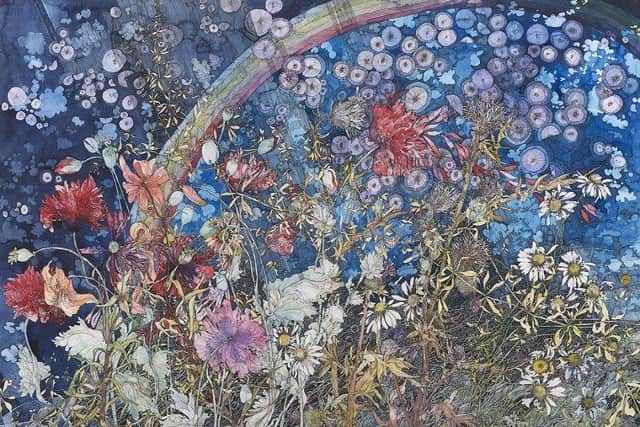Art reviews: George Jamesone | John Byrne | Una Shanks & Duncan Shanks | Frank Pottinger | Graeme Todd
George Jamesone: Painter of Kings, The Fine Art Society, Edinburgh ****
John Byrne: Blowin’ Wild, The Fine Art Society, Edinburgh ****
Advertisement
Hide AdUna Shanks & Duncan Shanks: Painters in Parallel, The Scottish Gallery, Edinburgh ****


Frank Pottinger: Landscape Plotted and Pieced, Royal Scottish Academy, Edinburgh ****
Graeme Todd, The Dream Lasted Well into the Evening, Royal Scottish Academy, Edinburgh ****
After his coronation in London, Charles III came to Scotland and was allowed to “handle” – but not put on – the ancient Scottish crown. His predecessors, Charles I and Charles II, both had proper Scottish coronations however. Charles II’s took place at Scone on 1 January 1651. In the midst of a brutal civil war, it was perhaps a bit hurried. Charles I however was crowned with full ceremony in Edinburgh on 18 June 1633. The king entered the city from Holyrood by the West Port, the junction of the High Street and Canongate. Triumphal arches on the Roman model, although temporary constructions of wood and canvas, not marble, were fashionable for royal entries. The West Port was an arch in situ. It was decorated and there “the Nymph Edina” presented the king with the keys of the city. He then passed through two temporary arches. At the first Caledonia made a speech. The second was in the High Street and on it “were painted Portraits of the Hundred and nine Kings of Scotland; within the Arch, Mercury was represented conducting Fergus, first King of Scotland, who, in a grave speech gave many paternal and wholesome Advices to Charles as his Royal Successor.” We don’t know how well Charles took to these “Advices”, but we do have evidence of the painted decoration. George Jamesone, the leading Scottish artist of the time, was commissioned to paint the 109 Scottish kings. Remarkably some of these paintings survive and 12 of them are currently on show at the Fine Art Society.
These witnesses to a great royal event nearly 400 years ago were preserved at Newbattle, home of the Marquis of Lothian. The Marquis’s ancestor, the Earl of Lothian, shared his monarch’s passion for collecting and evidently took some or all of the paintings when the arch was dismantled. The Scottish kings at Holyrood were painted 50 years later by Jacob de Wet and are (or were meant to be) copies of Jamesone’s originals, so they may all have survived till then. Thereafter, 26 stayed at Newbatle until 1971 when they were auctioned at Dowell’s auction house. No public body took any interest, and this extraordinary group of paintings was carelessly dispersed, largely without trace. Now, miraculously, a significant group has returned to Scotland and here they are united again with several companions that never left. It is a historic reunion.


Jamesone certainly didn’t paint all 109 kings and among these survivors the quality does vary, but some, like William Wallace, are striking. The inclusion of this non-royal hero among the kings of Scotland also seems very pointed. As king of England, Charles was successor to Edward I, Wallace’s brutal nemesis. It was perhaps a visual endorsement of those “paternal and wholesome Advices” offered by Fergus and intended to encourage Charles to respect Scotland’s status as an independent kingdom, or else see the spirit of Wallace arise again.
Advertisement
Hide AdPerhaps Charles III may now take an interest in these remarkable survivors of his predecessor’s coronation, but if he too had had a chance to have a Scottish coronation, no one would be better qualified to be his impresario, his modern Jamesone, than John Byrne, who is also showing at the Fine Art Society. There was an element of theatrical performance in Charles’s entry into Edinburgh and, of course, as well as being a supremely talented painter, Byrne has had a stellar career in the theatre and TV drama. It would have been amusing to see, for instance, his modern equivalents of Caledonia, Mercury and Fergus.
That was not to be however, but we do have a wide selection of his paintings and prints on show here. The earliest work, Child and Lion, dates from 1975 when he was still presenting himself to the world as the naive artist, Patrick. He returned to that alter ego too in a set of large prints with similar imagery made in the 1990s and again in a large painting called Love’s Arrow from 2009. His teddy boys and jazz musicians, evoking his boyhood in the 1950s, are familiar images, and there are several good examples here like Black Guy in Hat, for instance. The Black Jug, a fully developed cubist composition, is an example of his extraordinary virtuosity, but a bracketed subtitle (this way up) provides a typically irreverent note. He can deploy so much skill and yet question it at the same time. It perhaps suggests a link with the mood of his plays and TV dramas.
Advertisement
Hide AdAt the Scottish Gallery nearby, another veteran, Duncan Shanks is showing at along with his wife, Una Shanks. She is an exquisite painter of flowers, but not simply a flower painter. Her work is rarely seen, and there is only a small group of pictures here, a small number because such intensely wrought, complex compositions, worked up with highly observed detail, take time to paint. The detail doesn’t weigh them down, however, rather it creates a wonderful richness of effect.


In contrast, Duncan Shanks’s pictures have always been freely painted even if they too are often complex, with multiple layers of painting clearly visible on the surface as he works and reworks his image. While the show is not presented as a retrospective, the work here does range back over more than 50 years. Thus we can see how he has developed from relatively straightforward studies of nature towards the agitated surfaces of some of his recent works, where the observed landscape seems to dissolve into a very particular kind of abstract expressionism. Whether it’s the Clyde which flows past the Shanks’s garden, or the nearby burns that run into the river, water has always been a favourite subject. Here, for instance, there are several of his wonderful studies from the 1980s of these fast-flowing burns. There are, however, also paintings of dramatic skies seen from what used to be one of his favourite viewpoints, the top of nearby Tinto Hill. Like Van Gogh, he also paints the sun and one of his most recent works here is just that – a wonderful painting of the disk of a low sun blazing through the trees.
Meanwhile, the Academician’s Gallery at the Royal Scottish Academy presents memorial shows for two recently deceased academicians, Frank Pottinger and Graeme Todd. Pottinger’s work here consists principally of prints and small ceramic sculptures but there is also a small number of bronzes. The title of the show is Landscape Plotted and Pieced. It derives from Gerard Manley Hopkins’s poem Pied Beauty, and so invites us to see the landscape references in the ceramic sculptures (and ceramic, ultimately fired earth, is itself derived from the landscape). The word “pieced” in the title also suggests the way that these sculptures, though small, often echo elements of landscape in their earthy colours, or undulating forms.
Todd, meanwhile, was a painter whose work explores the edges of consciousness, places where things can seem to have a potent presence, yet are scarcely articulated, and perhaps would lose there solidity if we tried to look too directly at them. His imagery seems improvised yet doesn’t lose all reference. He also exploited surface in a fascinating way, apparently laying layers of resin over an image, giving it a mysterious depth, but then working on top of this transparent layer. The effect is to make the image seem not quite fixed in a concrete space, but rather floating in a mental space. It is all visually intriguing.
George Jamesone and John Byrne until 4 November; Una Shanks & Duncan Shanks until 28 October; Frank Pottinger and Graeme Todd until 15 October